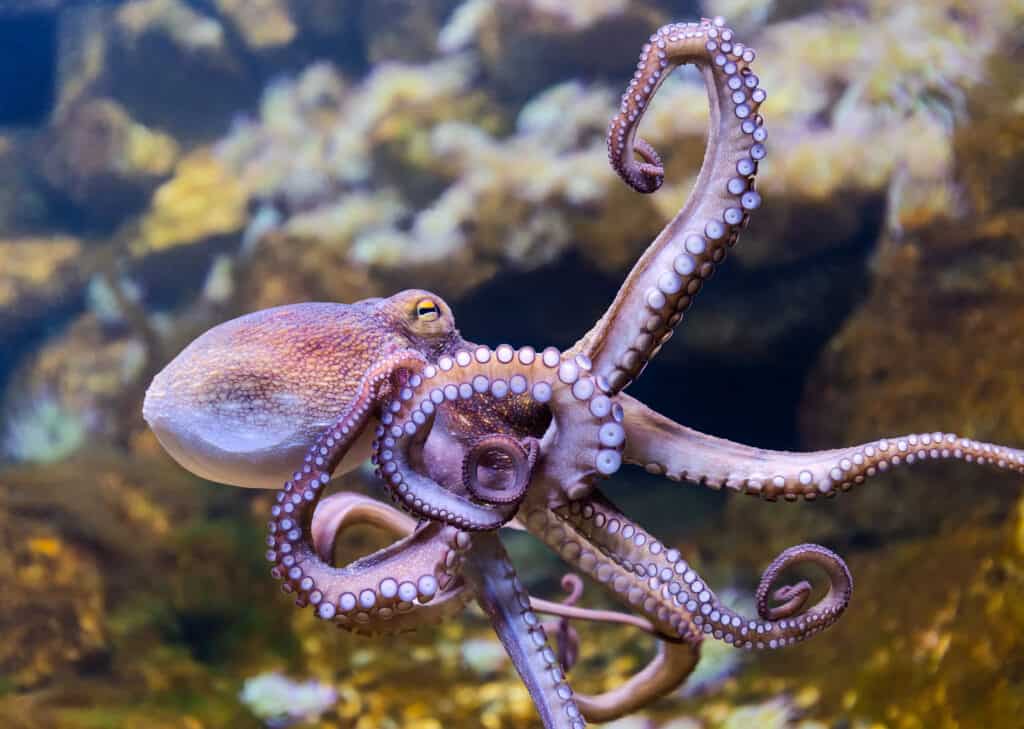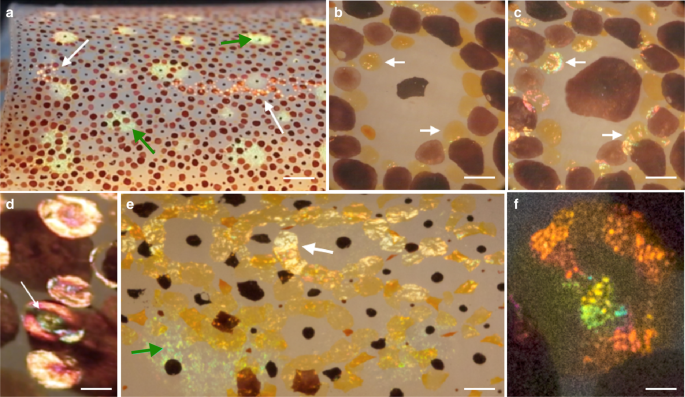How does the octopus communicate?

The octopus, an intelligent and enigmatic creature of the ocean, possesses a complex communication system that reflects its extraordinary cognitive abilities. Unlike many other marine species, octopuses are highly solitary creatures, and their communication methods are essential for various aspects of their lives, from navigation to reproduction.
The Octopus Brain and Intelligence
At the core of the octopus’s ability to communicate lies a sophisticated and decentralized nervous system, which underscores its extraordinary intelligence. Unlike vertebrates, including humans, whose centralized brains are housed within their skulls, octopuses possess a distributed neural network that extends throughout their bodies, with a significant portion residing in their eight arms.
Two-thirds of the octopus’s neurons are located in its arms, allowing for a degree of autonomy and intricate coordination unparalleled in the animal kingdom. This decentralization empowers the arms to process sensory information independently, enabling the octopus to execute complex tasks with remarkable dexterity. The flexibility of their neural architecture contributes to the octopus’s unparalleled ability to manipulate objects, navigate their environment, and engage in intricate behaviors.
The intelligence of octopuses extends beyond basic survival instincts. Observations in controlled environments have revealed their ability to solve complex puzzles, demonstrate short- and long-term memory, and exhibit learning behaviors.
The decentralized structure of their nervous system contributes to their capacity to adapt rapidly to changing circumstances, a crucial asset in the dynamic and often unpredictable underwater world they inhabit.
Chromatophores and Skin Patterns
Chromatophores are the artistic tools that allow octopuses to paint their bodies with a kaleidoscope of colors. These cells contain pigments, each responsible for a specific hue, and are under the direct control of the octopus’s nervous system. The arrangement and coordination of these pigments within the chromatophores enable the rapid and precise changes in color and pattern that define octopus communication.
As noted by researchers from the Marine Biological Laboratory in Woods Hole, Massachusetts, chromatophores are not only responsible for visual displays but also play a crucial role in the octopus’s ability to perceive light through its skin. The study highlights the multifaceted nature of chromatophores, emphasizing their role in both communication and sensory perception (Source: MBL Study on Octopus Chromatophores).
Dynamic Skin Patterns: A Visual Symphony
The octopus’s ability to change its skin pattern is akin to a visual symphony, with each movement and alteration conveying a specific message. These patterns are not arbitrary; rather, they serve a myriad of purposes, ranging from camouflage and signaling aggression to expressing emotional states. The chromatophores work in harmony to create intricate displays that captivate observers and communicate with other marine denizens.
When an octopus feels threatened, for instance, it might rapidly adopt a dark, mottled pattern to blend seamlessly with its surroundings. Conversely, a display of vibrant colors and undulating patterns may signify excitement, curiosity, or even a mating dance. The repertoire of skin patterns is as diverse as the octopus’s experiences, reflecting the complexity of their communication system.
Mimicry and Deception: Beyond Communication
The extraordinary control that octopuses exert over their chromatophores goes beyond communication; it extends to mimicry and deception. Some octopus species are renowned for their ability to imitate the appearance and behaviors of other marine creatures. This mimicry, facilitated by the intricate interplay of chromatophores, serves as both a defensive mechanism and a hunting strategy.

Body Postures and Movements
Octopuses are masters of morphological expression. They can assume various body postures, each laden with specific meanings that facilitate communication. A raised posture, where the arms are extended and lifted, often signals dominance or aggression. In encounters with potential threats or rivals, an octopus may adopt this posture as a visual assertion of its presence and readiness to defend itself.
Conversely, a flattened and elongated body posture signifies submission or fear. This response is not only a defensive strategy but also an essential element of social communication. When faced with a larger or more dominant conspecific, an octopus may flatten its body against the substrate, blending seamlessly with its surroundings. This posture not only serves as a form of self-preservation but also communicates a clear message of non-aggression and deference.
Beyond static postures, the fluidity of octopus movements contributes significantly to their communicative abilities. Octopuses are adept swimmers and agile crawlers, capable of navigating their environments with grace and precision.
Rapid changes in direction, sudden stops, or slow undulating motions all convey specific messages. For instance, a rapid retreat may indicate fear or evasion, while a slow, deliberate crawl might signal curiosity or exploration.
Chemical Signaling and Olfactory Communication
While the mesmerizing visual displays and intricate body movements of octopuses often steal the spotlight, chemical signaling and olfactory communication represent a vital and nuanced dimension of their interaction with the underwater world. The olfactory prowess of octopuses, facilitated by specialized glands and pheromones, adds a layer of complexity to their communication repertoire.
Pheromones and Reproductive Signaling
Octopuses deploy pheromones, chemical compounds that convey specific information, as a powerful means of communication, particularly in the context of reproduction. Specialized glands within the octopus’s body release these pheromones into the surrounding water, acting as molecular messengers that convey crucial details about the octopus’s reproductive status, health, and even emotional state.
The olfactory communication of octopuses is particularly pronounced during the mating season. Male octopuses, in their pursuit of a suitable mate, release pheromones into the water to attract females. The detection and interpretation of these chemical cues enable octopuses to navigate the complexities of reproductive encounters with precision.
Recognition and Individual Identity
Beyond reproductive signaling, chemical communication also plays a role in establishing individual identity and recognition within octopus communities. Each octopus has a distinct chemical signature, akin to a fingerprint, which allows them to identify conspecifics and potentially differentiate between friend and foe. This recognition is crucial for avoiding conflicts, establishing hierarchies, and facilitating cooperative behaviors, even in the typically solitary world of octopuses.
Environmental Exploration and Navigation
Olfactory communication extends beyond interpersonal interactions to serve practical purposes in the octopus’s daily life. Octopuses rely on their acute sense of smell to navigate their environment, locate prey, and assess potential threats. By releasing and detecting chemical cues in the water, octopuses can discern the presence of other organisms, identify suitable hunting grounds, and make informed decisions about their movements in their complex underwater habitats.
Complex Social Behaviors
While the octopus is generally considered a solitary and highly independent creature, certain species of octopuses display surprisingly complex social behaviors during specific life stages, particularly in the context of mating. The evolution of these behaviors provides a fascinating glimpse into the intricacies of octopus interactions, shedding light on the ways in which these intelligent cephalopods navigate their social landscape.
Octopuses are known for their transient and solitary lifestyle, often residing in crevices, caves, or seabed dens. However, when the mating season arrives, the dynamics shift, and certain species engage in elaborate courtship rituals that involve a variety of communication methods.
Tactile Courtship
Male octopuses, in particular, exhibit remarkable behaviors to attract potential mates. Their courtship rituals are a combination of visual displays, intricate body postures, and tactile interactions. The male octopus goes to great lengths to communicate his intentions and suitability as a mate, emphasizing the importance of effective communication even in the depths of the ocean.
One key aspect of this social interaction involves the male’s use of its specialized arm, the hectocotylus, to transfer sperm packets to the female. The male carefully extends this modified arm toward the female, navigating her response to determine her receptiveness. This tactile exchange serves not only as a means of reproduction but also as a form of communication, allowing the male to gauge the female’s level of interest and readiness to mate.
Visual Courtship
Beyond the physical interaction, visual displays play a crucial role in octopus courtship. The male may exhibit vibrant color changes, intricate patterns, and elaborate body postures to captivate the attention of the female. These visual signals convey information about the male’s health, vitality, and genetic fitness, all critical factors influencing the female’s choice of a mate.
Interestingly, the courtship rituals of octopuses can be highly individualized, with each male displaying a unique combination of behaviors. This diversity in courtship strategies suggests a level of complexity in octopus communication that goes beyond simple instinct, showcasing a degree of behavioral flexibility and adaptation to individual preferences.











I havе read so many posts regarding the blogger lovers
but this paragraph is really a goοd pieⅽe of writing, keep it up.